I’ve been thinking of making night blades for my R/C helicopter. Back in 2003 I made a set of wooden night blades for my Raptor 60 using RGB (Red-Green-Blue) LEDs and an Atmel AVR micro-controller to make them change colors and shift patterns. The blades were pretty simple but they worked. I even slapped together a set of LED color changing skids. I used very fine wire-wrap wire to interconnect everything. You can see these projects in this video below.
At the time that was a pretty advanced concept for night blades, though most night blades had multiple LEDs on them, I was more after proving the concept. The concept worked okay but the timing of the color changes was based on the predicted governor RPM speed of the blades. This resulted in the colors blurring and the colors not staying in their sectors on the rotor disc. The night skids were fun as well, but they suffered from exposure to the exhaust of the heli and eventually crazed and cracked. A 2-part clear coat system could have solved this problem but I didn’t know that at the time.
Fast forward 8 years to 2011. I am putting together plans to design some new electronics for night flying. I think I’ve learned quite a bit in the last few years so I believe it will be a fun project. If you saw my previous post on lighting the mini-titan you saw my discussion of a lot of LED strips which are available. Those will get used for the main fuse, but the blade electronics and lighting is going to be a scratch built project. This page will be updated as the project progresses so you can bookmark it and come back to see the latest information and details.
Some of the features which will definitely be in play with the new design.
- Synchronization of the LED patterns will be triggered with an infrared LED mounted to the frame of the helicopter. Each time a rotor blade passes over the infrared LED the micro-controller on the blades will pick up the pulse. This way the micro-controller will be able to adjust the timing of the display as the blade RPMs shift and change. With the rotors spinning at 2000 RPM there is a lot of sampling data available and it should be able to quickly track RPM changes.
- Li-Poly batteries. When I built the original electronics in 2003 Li-Poly batteries weren’t common place and were expensive. In 2011 I can buy a 3.7 volt 100mAh Li-Poly battery for 50 cents a piece.
- Controllable on and off via the R/C transmitter. The micro-controller can be programmed to turn the night blades on and off depending on if the infrared emitter on the frame of the helicopter is on or off. When the rotors are running the micro-controller will receive a constant stream of pulses from the infrared sensor on the blades. If the signal stops for x amount of milli-seconds, the controller can turn the rotor blade LEDs off.
- Manual power switch and charging jack. My old blades used disposable button cells. With the new setup being Li-Poly and rechargable I’m going to add a charging jack and a micro-switch for the main power. Charging will just be done through a 2s balance connector.
- I’m building this project on a 450 sized heli so it should scale up easily to larger sizes.
For now I’ve ordered up a bunch of surface mount LEDs, surface mount resistors, some copper tape and a bunch of batteries and other things. The dark is coming sooner and sooner this time of year so I’m going to whip up a set of simple night blades so I can fly a little later in the evenings hopefully and I’ll be working on the advanced night blade project as one of my Fall/Winter projects.
9/13/2011 – Development Tools
With some LEDs and other items on order I was eager to get setup to make some regular night blades, but I’m more excited to make some computerized night-blades. I cleaned off the desk top and got my development tools out and at the ready as seen in the picture below.
On the far left is the Atmel STK-500 AVR development board, then next to that, above is an Ethernet shield for my Arduino Duemilanove, below the Ethernet shield is my adapter for the 8 pin SOIC surface mount form factor and to it’s right is a row of ATtiny 12s in their plastic holder. In the next row top is the Arduino Duemilanove and below it is the Arduino Mega 2560, a beautiful board. To the right of that is one of my development breadboards and some jumper wires.
I’ll probably start with the ATtiny12s to run blades which have 2-3 LEDs per blade and for picking up the IR emitter on the boom (used to calculate RPM for visual effects and to let the blades know to light when spinning) and if I decide to go more complex I can use the Mega 2560. The ATtiny12L-4 chips that I have will run on 2.7 to 5.5 volts which makes them suitable to run on the 3.7v Li-Poly cells I plan on using on the night blades. Additionally it has a power down current of <1 uA and when active at 4Mhz/3V it consumes just 2.2mA.
The Ardunio Mega 2560 is a tantalizing subject for more advanced project experimentation because it has 54 digital inputs and outputs with 14 of them being Pulse Width Modulation (PWM) channels if desired. The ATMega2560 would be a difficult chip to hand solder into a night blade, but it could be assembled with many LEDs on a piece of flexible circuit board and SMD soldering techniques to build a very powerful POV night blade system.
I’ve ordered a 10x magnifying headset to help with soldering the small LEDs and I’ve also ordered up a 400x USB microscope to check out solder joints and other random things.
9/18/2011 – First Set of Night Blades and NEAT Fair 2011
My first set of LEDs and resistors I ordered from Digikey showed up on the 14th as did the spools of 5mm copper tape I ordered from Sparkfun. So I got busy building night blades using the technique posted on the HeliFreak forums. It took a couple of hours over a couple of evenings to make the first set using this method, I’m sure it’d go faster to make subsequent blades.
I took some closeup shots of the resistors and diodes to give some example of their size. They can be pretty small. I used 2x magnifying headset for some of the work though I probably could have done it without, it did make things easier.
Here’s the pictures of a red LED.
The resistors are about the same size as the LED in the first picture above. Here’s a closeup view so you can see where the conductive pads on the end are located and what they look like. These are the parts that need to be soldered end to end.
And this is the copper tape I used to make the traces on the blades. It’s self adhesive backed so you just press it onto the blades and then press it firmly into the blade with a fingernail or some else smooth that won’t tear the copper foil. 5mm is a bit wide for this kind of work so I used a very sharp razor blade to split it into smaller pieces. You can get 2-3 strips from 1 piece of copper length if you’re careful with the cuts. It’s very hard to get perfectly shaped pieces, and unfortunately it’s next to impossible to find a supplier of thinner copper tapes.
Here are the complete helicopter night blades I made, you can see the copper traces and the where I soldered them where they joined. I then used thin CA on the edges of the tape to help secure it to the blades. The batteries are little ones from an MSR helicopter, 3.7v at 120mAh. I soldered the tabs directly to the circuit traces and use a 3-pin connector to turn them on and also for charging. The next set I make I am just going to use the tiny battery connector and a proper lead, it will be much cleaner and easier to use.
One important thing to make note of is that the edges of carbon fiber blades are conductive, in order to make carbon fiber night blades you need to insulate the edges before you put the copper foil over the edge. I used clear nail polish and brushed it on over the edges of the blade, but only in the spots where the copper was wrapping around the night blade. Coating the hole edge would add more weight and is not neccesary. I originally only had 2 LEDs per blade and the tested current draw was 37 milli-amps (.037 Amps). The LEDs are rated at about 20mA a piece so the current draw was well within usable range and I could see that there were no shorts causing excessive current draw.
After adding 1 additional LED to each night blade, for a total of three per blade things were looking pretty good. Here’s a picture of the blades top and bottom. You can see some hazing on the surface of the blades, this is caused by the thin CA I used, and can be removed with a little work.
 And here’s a photo of the LED night blades before I added the red and white LEDs (red on bottom, white on top) to help identify the tops and bottoms of the rotor disc.
And here’s a photo of the LED night blades before I added the red and white LEDs (red on bottom, white on top) to help identify the tops and bottoms of the rotor disc.
I was going to fly the blades at the NEAT fair 2011 but I had a lockout on my Airtronics radio for some reason and did some minor damage to the helicopter. I saw someone else down there flying a 450 with LEDs on the frames but he didn’t have lighted rotor blades so I offered to loan his mine. He’d get to see his heli with night blades and I’d get to see the night blades on a heli at NEAT. Good deal!
I already have some ideas for changing the layout of the LEDs, but since the next pair will be driven by a micro-controller for some POV rotor blade games those plans may change as well. I think the next pair the outer LEDs will be closer to the outer edge of the rotor blades, and perhaps there will be several LEDs in each position, side by side to make for wider bands of light. The night blades were very visible though a bit dimmer than the main LEDs on the body of the helicopter. I have some much brighter LEDs on the way from a Chinese company.
More updates to come, thanks for reading and boomark this page and check back later to see what else I’m doing with LED Night Blades.

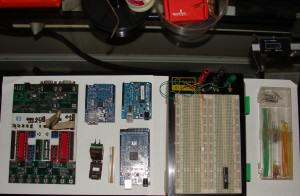
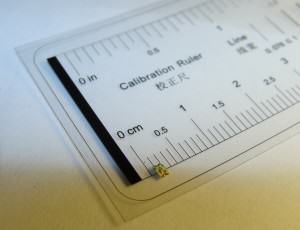
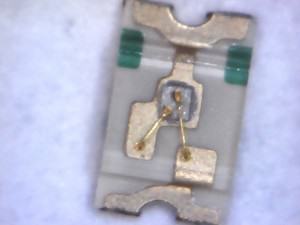
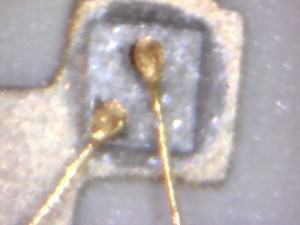
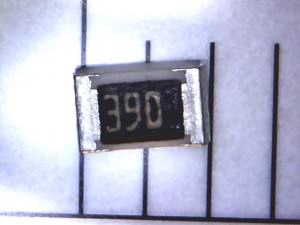
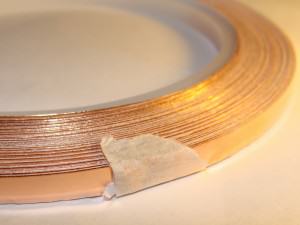
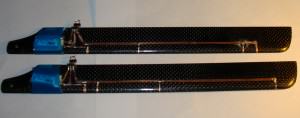
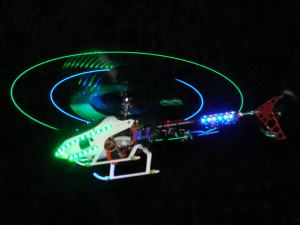
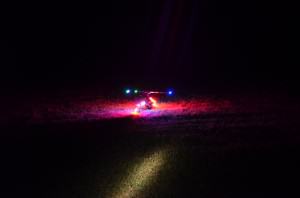
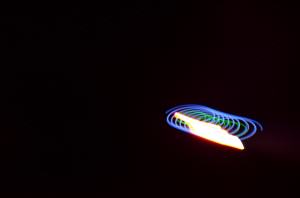
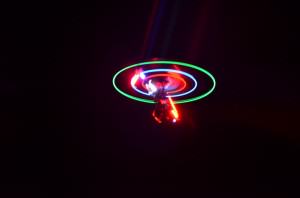
2 responses to Making Night Blades for R/C Helicopter
I would love to see how you soldered the leds in more detail. I just bought what I assume is the exact same tape, and I already taped it to one of the blades in original width, figuring it didn’t matter it was so wide. But now I have no idea how I am going to solder the leds on there, oh well.
John, I’ll see if I can get a video of the soldering job this weekend. It’s not particularly difficult but took a bit to figure out the first time. I solder the resistor to the LEDs first. I tape the LED to a glass table top and tin the exposed end of the LED and then push the resistor up next to it and hold it with a toothpick while heating up the LED and resistor contacts, then hold it till it cools. Once you have these little LED+Resistor modules you can put them on the copper strips, get a little solder on the tip of your soldering iron and bond the joint. I use my finger to hold the LED down while soldering the first joint, but it may be too hot and a toothpick would work fine.
Leave a reply to Making Night Blades for R/C Helicopter